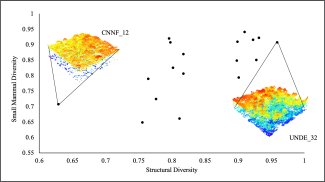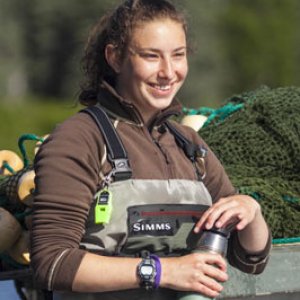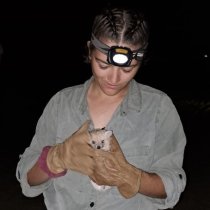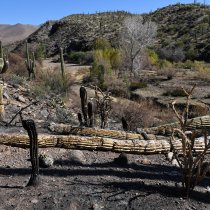Case Study
A Big Idea for Small Mammal Diversity Modeling
February 10, 2020
You can't see chipmunks, mice and voles from an airplane—especially when they are scampering beneath the forest canopy or burrowing in the ground. But a new modeling approach could allow researchers to use remote sensing lidar data to predict small mammal biodiversity based on the structure of vegetation in an area.

Graduate student Sarah Schooler writing in the field
The study was led by Sarah Schooler, now a Ph.D. candidate at State University of New York (SUNY)–Syracuse, and Harold Zald of the Humboldt State University Department of Forestry and Wildland Resources. Sarah’s experience working as a seasonal NEON field botanist inspired her to find innovative ways to use data from the NEON project. Lidar Prediction of Small Mammal Diversity in Wisconsin, published in Remote Sensing, explores how measurements of vegetation structure created with lidar data could be used to predict the diversity of small mammal communities.
A Lidar-based Predictive Model for Small Mammal Diversity
Sarah's inspiration for the study came from her work with the NEON project and her experiences with her mentor and professor at Humboldt State, Dr. Harold Zald. His advanced remote sensing class introduced her to remote sensing methods and gave her the skills she needed to put the data to work.
Vegetation structure is known to be correlated with diversity for many taxa of animals, including birds, mammals and insects. A single forest can provide a range of habitats, from areas with dense canopy cover and a relatively open understory to areas with a thick understory of brush, shrubs and a variety of herbaceous plants. Different animal species prefer different types of habitats. Most models predict that areas with more diverse vegetation structure will also support more diverse animal communities.
Traditionally, vegetation structure has been evaluated with painstaking fieldwork. Lidar (Light Detection And Ranging) is a remote sensing system that uses pulses of light to measure vegetation height and 3D structure. The NEON project uses lidar data collected using the Airborne Observation Platforms (AOPs) to construct 3D models of vegetation structure at NEON terrestrial field sites. Using lidar, researchers can quickly gather information about canopy height and complexity, canopy cover, and understory complexity over very large areas.
Sarah wanted to find out whether lidar data could be used to predict small mammal diversity at the NEON field sites in Wisconsin. Using small mammal counts and lidar data from the NEON Data Portal, she found that lidar-derived variables (including structural diversity, canopy cover and canopy complexity) were highly predictive of small mammal diversity at the sites. Plots with higher levels of structural diversity and canopy complexity were correlated with more diverse small mammal communities.

Sarah's data shows that structural diversity of vegetation is correlated with higher diversity in small mammal populations.
The study suggests that lidar data could be a useful tool for building models of small mammal diversity across large areas. Small mammal diversity is an important indicator of ecosystem health. "This is a proof-of-concept study," Sarah says. "More work needs to be done to determine whether this model can be applied to other types of ecosystems. But it's an important first step. Moving forward, hopefully people will expand on it and get concrete data from other ecosystems to build out the predictive model."
From Plants to Bears, and Everything in Between
Sarah's interest in data-driven approaches to ecological modeling grew out of her work at the NEON field sites in Wisconsin during the summer of 2017. But her interest in ecology goes back much further than that. Growing up near Madison, Wisconsin, Sarah always had a great appreciation for wildlife and the outdoors. She was thrilled to discover in high school that she could turn these passions into a career in ecology. She went on to earn dual degrees from the University of Washington, with B.S. degrees in Environmental Studies and Environmental Science and Resource Management, and an M.S. degree in Wildlife Biology from Humboldt State University.
Her field experiences have been varied and far ranging. She has studied bears and salmon with the University of Washington Fisheries Research Institute, served as a Fisheries technician for the Washington Department of Fish & Wildlife, conducted visual and radio tracking of cranes for the International Crane Foundation, and worked with the Michigan Department of Natural Resources both in the field and in the lab. Her master’s program took her to Kenya to study the ecology of avian insectivores and insect pests on coffee farms.
She first learned about the NEON project in 2017, when she ran across a posting for summer field technicians. That summer, before starting her master's program, she worked as a Botany Technician for the NEON terrestrial field sites in Wisconsin. This job took her into the woods, fields and wetlands to conduct surveys of plant diversity, assess course woody debris and leaf litter, and collect root samples for analysis.
Sarah says, "This was a great job for me. Working with the NEON project gave me some really important experiences. They treat their employees really well, and you have the opportunity to develop a wide diversity of skills. I would recommend the experience to any recent ecology graduate."
She also gained exposure in data-driven research methods and became aware of the huge trove of data that is publicly available on the NEON Data Portal. Without that exposure, she says, her paper on small mammal diversity would never have come to pass.
A Lasting Appreciation for Data-Driven Ecology
Sarah is now enrolled in a Ph.D. program at SUNY–Syracuse, in the School of Environmental Science and Forestry. Her current research focus is on timber harvesting and predator-prey relationships between elk and brown bear in the Kodiak Archipelago.
While her current research does not utilize data from the NEON project, Sarah's work with NEON has given her a lasting appreciation of the power of data-driven research methods in ecology. "I love collecting data, but I'm even more interested in analyzing data," she says. "As a field technician, you collect the data but you don't get to see where it leads."
She sees tremendous value in the data being collected by the NEON project, especially for graduate students. She says, "I wouldn't have been able to complete [the small mammal diversity study] without the publicly available data from NEON. I had no external funding, and I would never have been able to collect the lidar data on my own. It's really amazing to have data of this quality and scope available online."
As she moves into teaching, Sarah plans to introduce her students to NEON data. "Getting fieldwork experience is important, but remote sensing data enables scientists to scale up projects from surveyed plots to larger areas, allowing students and scientists to ask research questions that are not possible with field data alone. It's a different way of studying ecological trends."


